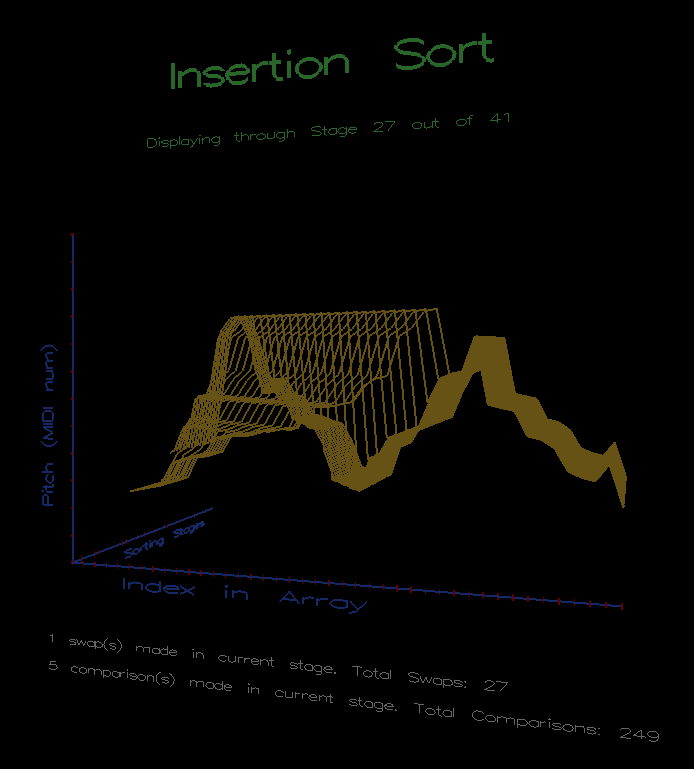
midisort: sonification & visualization of sorting algorithms using MIDI note number (for Mac OSX)
Music 256: Music | Computing | Design (Autumn 2008-2009)
Final Project by Jieun Oh

project motivation & vision
My goal for the Music 256 final project is to sonify and visualize elementary sorting algorithms-- because programming (and learning about programming concepts) is fun, especially with auditory and visual interactions!
Depending on the success of this mini-project, I’d like to consider the greater vision of sonifying andvisualizing concepts in programming and discrete math, such as sorting and searching algorithms; recursive functions; path finding in graphs/ trees and coloring of their nodes. It would also be interesting to be able to evaluate data structure choices—arrays, linked lists, map, trees, etc—given a context of tasks to perform.
specifications
minimal essential system (implemented, as of 12/12/2008)
- Input a sequence of midi-notes: Live input using a MIDI keyboard or other MIDI devices
- Display the original input based on pitch information
- Sort the pitch using a selected sorting algorithm, visualizing and sonifying the process
- Display the resulting sorted pitch information
- Display algorithm evaluation: track timing, swap, comparisons statistics
beyond minimal: other desirable features (in progress and not yet incorporated, as of 12/12/2008)
- Do all of the above preserving the rhythm information associated with each note: makes it more musical and fun
- Add an option to read input from an existing MIDI file
- Have an interface to compare algorithms
- Be able to specify the comparison function to define the “ascending order" (i.e. using not necessarily MIDI key number; other obvious possibilities are rhythmic and velocity information in ascending or descending order)
milestones (as planned on 11/21/2008; this schedule was modified in various ways in practice!)
- figure out various sorting algorithms (import from somewhere…) – over Thanksgiving
- setup MIDI input to correctly read and save pitch data – over Thanksgiving
- visualize and sonify the original array of pitches – over Thanksgiving
- visualize and sonify the sorted outcome – over Thanksgiving
- visualize and sonify the sorting process – by 12/4
- work on displaying algorithm evaluation – by 12/7
- work on “other desirable features” – post 256, possibly over winter break!
software design overview
- approx. 30% from HW 2 (MIDI input played through Karplus-Strong algorithm implementation)
- approx. 30% from HW3 (modified OpenGL "waterfall" code from sndpeek)
- approx. 40% "new": applying sonification and visualization techniques to various sorting algorithms
implementation (designed for Mac OSX)
download .zip file --or -- page with individual files
documentation
README (also downloadable from above):
[1] How to run
You will need the following files:
(download from http://ccrma.stanford.edu/~jieun5/256/midisort.zip)
- midisort.cpp: main file for the program
- RtAudio.h, RtAudio.cpp, RtError.h: for real time audio capabilities
- RtMidi.h, RtMidi.cpp: for MIDI input
- Karplus.h, Karplus.cpp: implementation of the Karplus-Strong algorithm used in RtAudio callback
- makefile
To run:
- connect an MIDI input and test port with the optional midiprobe file
- type "make" followed by ./midisort (optional addition: -bubble -selection -insertion -shell to specify algorithm)
- input MIDI notes. once done, press enter
- graphics window will show up. click on the window to make it active.
- enter appropriate keyboard command to manipulate
- press 'h' anytime for keyboard controls help menu
- press 'q' to quit
Note:
To manually populate MIDI key numbers (instead of using an input device), set g_MIDIin (line 85) to be false. Then specify the desired key numbers in the setupMidiInput function (line 218).
[2] Functionality
- input options: MIDI device or manual note-number specification
- choice of sorting algorithms: bubble sort, insertion sort, selection sort, shell sort
(these are popular sorting algorithms that can be easily implemented with array/ vector data structure;
other algorithms, such as merge sort and quick sort was omitted because they require different structures
and involve a different kind of analysis for statistics calculation.)
- play, repeat, or skip forward stages until the note-sequences are completely sorted (with keyboard inputs)
- plays the midi notes in plucked string sound, and visualizes the contour using a line graph for each stage visited
- rotate, tilt, and zoom z-axis for the graphics (using keyboard inputs)
[3] Bugs & Things to Improve on
- currently the program is fragile with occasional bus errors :(
- need to take care of memory cleanup
- feature to add #1: preserve the rhythm with which the notes were added when sorting and playing through stages
- feature to add #2: have an interface to easily compare two (or more) algorithms using the same input notes
- feature to add #3: have an option to read data from a midi file
- define comparison function to specify what to sort in what order
[4] Reflections
- keeping track of various threads running simultaneously was troublesome (I could not master mutex/ lock/ wait placements that would get rid of the unpredictable bus error.)
- still having a difficult time how the coordinate system works in OpenGL: the way it is done now is a result of trial-and-error, and by no means is done using the correct "logic" (as as result, changing a parameter may have unwanted side-effects on the positioning/ viewing of other features.)
- it was fun to be able to incorporate code used from the past (specifically HW2 and HW3) and re-use them constructively
- Sorting real-time as we step through vs. storing each stages of the sorting algorithm and accessing them after the fact: chose the latter option, but as a result had to use a fairly large vector of vectors.
- I like the outcome: it's quite fun to see and hear what the algorithm does to pitch pattern